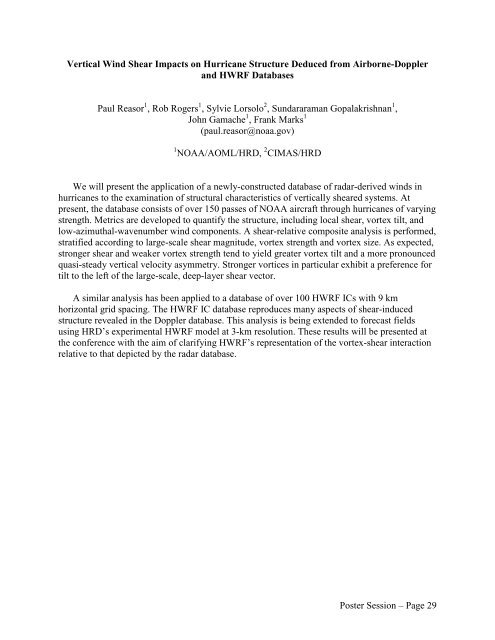65th IHC Booklet/Program (pdf - 4.9MB) - Office of the Federal ...
65th IHC Booklet/Program (pdf - 4.9MB) - Office of the Federal ...
65th IHC Booklet/Program (pdf - 4.9MB) - Office of the Federal ...
You also want an ePaper? Increase the reach of your titles
YUMPU automatically turns print PDFs into web optimized ePapers that Google loves.
Vertical Wind Shear Impacts on Hurricane Structure Deduced from Airborne-Doppler<br />
and HWRF Databases<br />
Paul Reasor 1 , Rob Rogers 1 , Sylvie Lorsolo 2 , Sundararaman Gopalakrishnan 1 ,<br />
John Gamache 1 , Frank Marks 1<br />
(paul.reasor@noaa.gov)<br />
1 NOAA/AOML/HRD, 2 CIMAS/HRD<br />
We will present <strong>the</strong> application <strong>of</strong> a newly-constructed database <strong>of</strong> radar-derived winds in<br />
hurricanes to <strong>the</strong> examination <strong>of</strong> structural characteristics <strong>of</strong> vertically sheared systems. At<br />
present, <strong>the</strong> database consists <strong>of</strong> over 150 passes <strong>of</strong> NOAA aircraft through hurricanes <strong>of</strong> varying<br />
strength. Metrics are developed to quantify <strong>the</strong> structure, including local shear, vortex tilt, and<br />
low-azimuthal-wavenumber wind components. A shear-relative composite analysis is performed,<br />
stratified according to large-scale shear magnitude, vortex strength and vortex size. As expected,<br />
stronger shear and weaker vortex strength tend to yield greater vortex tilt and a more pronounced<br />
quasi-steady vertical velocity asymmetry. Stronger vortices in particular exhibit a preference for<br />
tilt to <strong>the</strong> left <strong>of</strong> <strong>the</strong> large-scale, deep-layer shear vector.<br />
A similar analysis has been applied to a database <strong>of</strong> over 100 HWRF ICs with 9 km<br />
horizontal grid spacing. The HWRF IC database reproduces many aspects <strong>of</strong> shear-induced<br />
structure revealed in <strong>the</strong> Doppler database. This analysis is being extended to forecast fields<br />
using HRD’s experimental HWRF model at 3-km resolution. These results will be presented at<br />
<strong>the</strong> conference with <strong>the</strong> aim <strong>of</strong> clarifying HWRF’s representation <strong>of</strong> <strong>the</strong> vortex-shear interaction<br />
relative to that depicted by <strong>the</strong> radar database.<br />
Poster Session – Page 29
















